The ASUS Z170-A Motherboard Review: The $165 Focal Point
by Ian Cutress on October 20, 2015 2:00 PM EST- Posted in
- Motherboards
- Asus
- ATX
- Skylake
- Z170
System Performance
Not all motherboards are created equal. On the face of it, they should all perform the same and differ only in the functionality they provide - however this is not the case. The obvious pointers are power consumption, but also the ability for the manufacturer to optimize USB speed, audio quality (based on audio codec), POST time and latency. This can come down to manufacturing process and prowess, so these are tested.
Power Consumption
Power consumption was tested on the system while in a single MSI GTX 770 Lightning GPU configuration with a wall meter connected to the OCZ 1250W power supply. This power supply is Gold rated, and as I am in the UK on a 230-240 V supply, leads to ~75% efficiency > 50W, and 90%+ efficiency at 250W, suitable for both idle and multi-GPU loading. This method of power reading allows us to compare the power management of the UEFI and the board to supply components with power under load, and includes typical PSU losses due to efficiency. These are the real world values that consumers may expect from a typical system (minus the monitor) using this motherboard.
While this method for power measurement may not be ideal, and you feel these numbers are not representative due to the high wattage power supply being used (we use the same PSU to remain consistent over a series of reviews, and the fact that some boards on our test bed get tested with three or four high powered GPUs), the important point to take away is the relationship between the numbers. These boards are all under the same conditions, and thus the differences between them should be easy to spot.
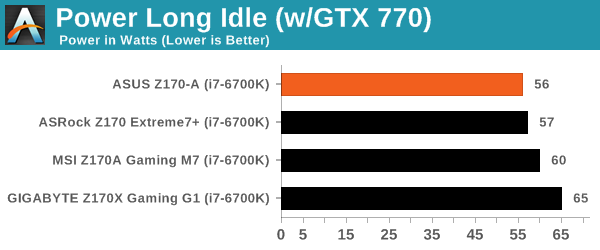
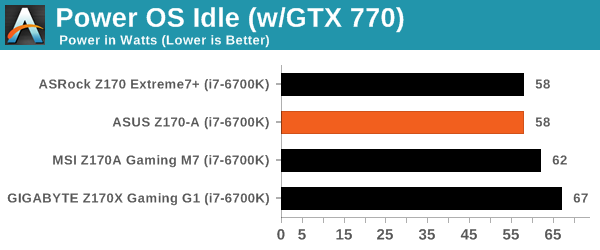
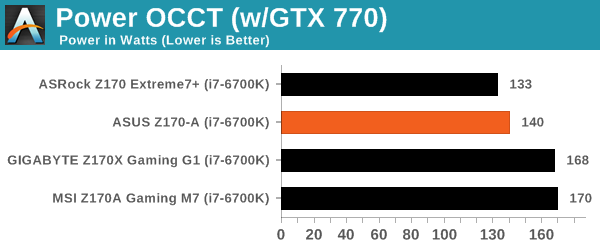
The power profile of the ASUS Z170-A when idle and loaded does well, but it is worth noting here that with these motherboards, those that implement a form of MultiCore Turbo on the K series processors also seem to increase the voltage, especially at load.
Non UEFI POST Time
Different motherboards have different POST sequences before an operating system is initialized. A lot of this is dependent on the board itself, and POST boot time is determined by the controllers on board (and the sequence of how those extras are organized). As part of our testing, we look at the POST Boot Time using a stopwatch. This is the time from pressing the ON button on the computer to when Windows 7 starts loading. (We discount Windows loading as it is highly variable given Windows specific features.)
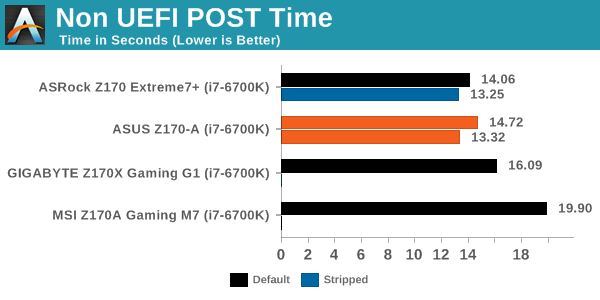
We're still in the early days for non-UEFI POST time optimization, but at this point in testing a sub-15 second result seems to be what to aim for.
Rightmark Audio Analyzer 6.2.5
Rightmark:AA indicates how well the sound system is built and isolated from electrical interference (either internally or externally). For this test we connect the Line Out to the Line In using a short six inch 3.5mm to 3.5mm high-quality jack, turn the OS speaker volume to 100%, and run the Rightmark default test suite at 192 kHz, 24-bit. The OS is tuned to 192 kHz/24-bit input and output, and the Line-In volume is adjusted until we have the best RMAA value in the mini-pretest. We look specifically at the Dynamic Range of the audio codec used on board, as well as the Total Harmonic Distortion + Noise.
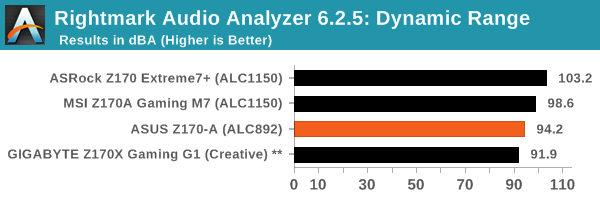
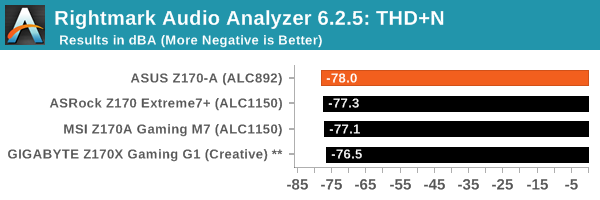
ASUS' use of the ALC892 naturally gives it an SNR disadvantage for dynamic range, but we see it do well in the distortion plus noise test.
USB Backup
For this benchmark, we transfer a set size of files from the SSD to the USB drive using DiskBench, which monitors the time taken to transfer. The files transferred are a 1.52 GB set of 2867 files across 320 folders – 95% of these files are small typical website files, and the rest (90% of the size) are small 30 second HD videos. In an update to pre-Z87 testing, we also run MaxCPU to load up one of the threads during the test which improves general performance up to 15% by causing all the internal pathways to run at full speed.
Due to the introduction of USB 3.1, as of June 2015 we are adjusting our test to use a dual mSATA USB 3.1 Type-C device which should be capable of saturating both USB 3.0 and USB 3.1 connections. We still use the same data set as before, but now use the new device. Results are shown as seconds taken to complete the data transfer.
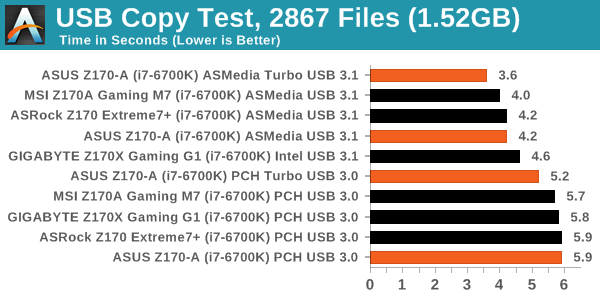
ASUS' use of Turbo drivers puts it at the top of the list for USB 3.0 and USB 3.1, although the stock speeds fall near the bottom in our small sample.
DPC Latency
Deferred Procedure Call latency is a way in which Windows handles interrupt servicing. In order to wait for a processor to acknowledge the request, the system will queue all interrupt requests by priority. Critical interrupts will be handled as soon as possible, whereas lesser priority requests such as audio will be further down the line. If the audio device requires data, it will have to wait until the request is processed before the buffer is filled.
If the device drivers of higher priority components in a system are poorly implemented, this can cause delays in request scheduling and process time. This can lead to an empty audio buffer and characteristic audible pauses, pops and clicks. The DPC latency checker measures how much time is taken processing DPCs from driver invocation. The lower the value will result in better audio transfer at smaller buffer sizes. Results are measured in microseconds.

DPC is still something that needs to be optimized for, and we're still early in the lifespan of the 100-series motherboards so we would expect this to improve over time. Nonetheless, the ASUS has scored best so far.










29 Comments
View All Comments
Kutark - Sunday, November 1, 2015 - link
Gigabyte is your friend.Haravikk - Thursday, October 29, 2015 - link
I'm still disappointed by motherboards are lumbered with DVI, VGA and PS/2 ports after so many years. An adapter from Displayport will handle conversion to DVI or VGA just fine for about $15, so why waste space on connectors that most people won't use? Even HDMI is fairly redundant as how many people are really going to use a motherboard like this without adding discrete graphics? One connector is ample as a fallback, anything else is just wasting space.I'd much rather see more USB ports, as no matter how much I try to prune my usage, I always seem to run out and end up having to add hubs, and I've yet to find a hub that I actually like; they're almost always cheap crap (regardless of price point) and usually require external power even when they claim bus-power is enough. If I were designing my ideal motherboard the I/O section would have the maximum number of USB ports that I can squeeze onto it (without making it hard to use chunkier connectors); sure they'll be sharing bandwidth, but the majority of USB devices don't require that much.
V900 - Friday, October 30, 2015 - link
Ehm... Plenty of people still use both DVI/VGA and PS/2 connections.I just built a system this year, that got hooked up to an older monitor with a VGA cable.
The older ports have some advantages over newer DP/HDMI ports, and as for PS/2 connectors: Maybe if you used one for your kb/mouse you wouldn't run out of USB ports as fast?
Kutark - Sunday, November 1, 2015 - link
People seriously run out of USB ports? How?ablevy - Monday, November 2, 2015 - link
There are two USB 2.0 headers ion the MB for adding additional USB ports. I'm not sure how many additional ports they support , but I think you could get four ports off them.Oxford Guy - Sunday, November 1, 2015 - link
"there are two major camps on the issue"The unstable and the stable camps?
Mlr - Tuesday, November 10, 2015 - link
Purchased a high end ROG MOTHBOARD by Asus. Delivered dead. Finally obtained return ticket. Now, supposedly, repaired but has an issue noted on the net and their site that the usb ports shutoff. They have never addressed the problem. When I sued rather than honor the warranty they spent $5000.00 in attorneys fees instead of just sending another board. I promised myself to never be at their mercy again. Google maximus iv extreme z and usb problems before you trust them. Be warned.